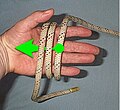Angler's loop
| Angler's loop | |
|---|---|
Loop | |
| Releasing | Jamming |
| Typical use | Fishing, forming a fixed loop in bungee cord |
| ABoK | #1017, #1035, #2067 |
| Instructions | [1] |
An angler's loop, otherwise known as a perfection loop, is a type of
loop. Useful for fine or slippery line, it is one of the few loop knots which holds well in bungee cord. It is quite secure, but it jams badly and is not suitable if the knot will need to be untied.[according to whom?
]
Tying
Angler's loop may be tied
- alone and then used,
- it may be tied in the bight or at the working end
- it may be tied one handed
- it may be fashioned with several loops
- it may be locked for additional stability
- it may be tied at high speed in an emergency
- it may be tied through an object (typically a ring).


-
Start with a loop near the working end
-
Continue with two loops around standing end
-
one large and one small in the middle
-
Pull the large loop over the small (working end) and through the first loop
-
Tighten pulling in all three directions.
Angler's loop may be tied around the hand, it may also be tied this way one handed, or with several loops if need be:
-
Hold the working end, loop the standing end 3 times around the palm
-
Pull the outmost loop inwards under the first two
-
Pull the next outmost over the one(s) in the middle and under the now innermost loop
-
Pull the now innermost loop(s) and the standing end to tighten.
-
Done.
- Angler's loop may be locked additionally with half hitches

- Angler's loop may be fashioned with several loops (then locking may be necessary)

Structure
half-hitch by the working end
.
See also
References
- Blandford, Percy W. (2012) Practical Knots and Ropework page 92, Courier Corporation. ISBN 9780486148656
- Bloomsbury Publishing (2013) The Knot Bible: The Complete Guide to Knots and Their Uses page 143. A & C Black. ISBN 9781408155875
- Budworth, Geoffrey (2012) The Knot Book Hachette UK. ISBN 9780716023159
- Finazzo, Scott (2016) Prepper's Guide to Knots: The 100 Most Useful Tying Techniques for Surviving any Disaster page 117, Ulysses Press. ISBN 9781612436302
- Popular Mechanics (2008) How to Tempt a Fish: A Complete Guide to Fishing page 78, Sterling Publishing Company. ISBN 9781588167262
- Toss, Brion and Gae Pilon (2009) Chapman Knots for Boaters pages 68–68, Sterling Publishing Company. ISBN 9781588167781
- Whippy, Jim (2013) Reeds Knot Handbook: A Pocket Guide to Knots, Hitches and Bends pages 82–83, A & C Black. ISBN 9781472902610
External links
- Perfection (Angler's) Loop Knot. animatedknots.com.










